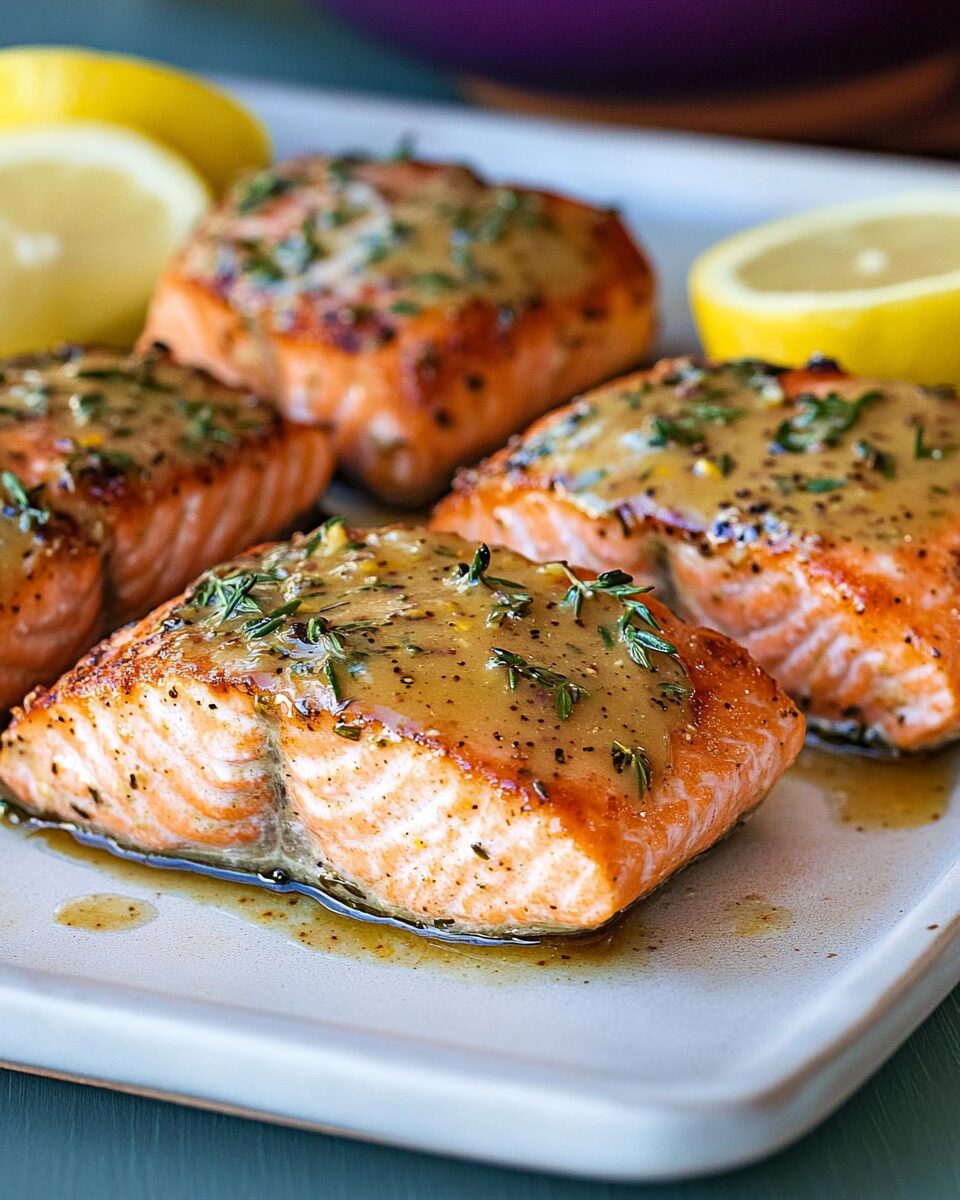The bold flavors of Dijon and whole-grain mustard marry beautifully with fresh herbs and olive oil in this quick and elegant broiled salmon dish. The crispy, caramelized glaze contrasts with the buttery texture of perfectly cooked salmon, making it a satisfying and healthy centerpiece for any meal.
Whether you’re hosting a dinner party or craving a midweek treat, this dish delivers both simplicity and sophistication. With just 12 minutes of prep and under 20 minutes from start to finish, it’s a dream for busy home cooks who don’t want to sacrifice flavor. The lemon wedges at the end add a final burst of brightness, rounding out a dish that’s as beautiful as it is delicious.
Full recipe:
Ingredients:
-
2 garlic cloves
-
3/4 teaspoon finely chopped fresh rosemary leaves
-
3/4 teaspoon finely chopped fresh thyme leaves
-
1 tablespoon dry white wine
-
1 tablespoon extra-virgin olive oil
-
2 tablespoons Dijon mustard
-
2 tablespoons whole-grain mustard
-
Nonstick olive oil cooking spray
-
Six 6- to 8-ounce salmon fillets
-
Salt and freshly ground black pepper
-
6 lemon wedges
Directions:
-
In a mini food processor, blend together garlic, rosemary, thyme, wine, olive oil, Dijon mustard, and 1 tablespoon of the whole-grain mustard until well combined (about 30 seconds).
-
Transfer the mixture to a small bowl and stir in the remaining tablespoon of whole-grain mustard. Set aside.
-
Preheat the broiler and line a heavy-rimmed baking sheet with foil. Spray foil with nonstick olive oil spray.
-
Place the salmon fillets on the prepared baking sheet. Season each fillet with salt and freshly ground pepper.
-
Broil the salmon for 2 minutes.
-
Spoon the herb-mustard glaze evenly over the fillets.
-
Continue to broil for about 5 more minutes, or until the salmon is cooked through and golden brown on top.
-
Serve immediately with lemon wedges on the side.
Prep Time: 12 minutes | Cooking Time: 7 minutes | Total Time: 19 minutes
Kcal: Approximately 310 kcal per serving | Servings: 6 servings
The Flavor Profile: A Harmonious Blend
The highlight of this salmon dish is undoubtedly its glaze—a potent combination of Dijon mustard, whole-grain mustard, fresh rosemary, thyme, garlic, olive oil, and dry white wine. Each component contributes something unique:
-
The Dijon mustard provides sharpness and creaminess.
-
The whole-grain mustard adds texture and a subtle tang.
-
Fresh rosemary and thyme bring earthy, woody notes.
-
Garlic deepens the flavor, adding a punch of umami.
-
Olive oil adds richness and silkiness.
-
A splash of dry white wine introduces acidity and brightness.
Together, these ingredients create a glaze that caramelizes slightly under the broiler, enhancing the salmon’s flaky texture and offering a slightly crispy, golden finish on top.
Why Broiling Works So Well for Salmon
Broiling is an underrated yet incredibly effective cooking method for fish. It cooks at high heat from above, allowing the glaze to form a crust while sealing in the moisture of the salmon. The result is a perfectly cooked fillet that’s crisp on the outside and tender on the inside.
Salmon naturally contains healthy fats, which means it stays moist and flavorful even under intense heat. Broiling allows these fats to render slightly, enriching the texture without requiring added butter or heavy sauces. For anyone seeking a nutritious cooking method that doesn’t compromise taste, broiling is a winning choice.
The Nutritional Benefits of Salmon
Salmon is often hailed as a “superfood” for good reason. It is incredibly nutrient-dense and offers a wide array of health benefits:
-
Rich in Omega-3 Fatty Acids: These essential fats support heart health, reduce inflammation, and may even enhance brain function.
-
High in Protein: A single serving provides a significant portion of your daily protein needs, which is essential for muscle maintenance and repair.
-
Loaded with Vitamins and Minerals: Salmon is a great source of B vitamins, particularly B12 and B6, as well as vitamin D, selenium, and potassium.
This recipe aligns beautifully with a health-conscious diet, making it suitable for those following low-carb, gluten-free, keto, or Mediterranean-style eating plans.
Wine Pairing Suggestions
Giada’s original pairing for this dish recommends a Dolcetto—a light-bodied red wine from Italy. This choice is unexpected, as salmon is typically paired with white wine. However, the earthy, fruity tones of Dolcetto harmonize well with the mustard and herbs in the glaze.
For those who prefer white wine, a crisp Sauvignon Blanc or a dry Riesling would complement the tangy mustard and fresh herbs without overwhelming the dish. Avoid heavily oaked wines, as their boldness can overshadow the subtlety of the glaze.
Serving Ideas and Complementary Dishes
This salmon dish pairs well with a variety of sides, offering flexibility depending on your preferences or dietary needs:
-
For a light meal: Serve with a side of arugula or spinach salad dressed in lemon vinaigrette.
-
For a heartier option: Accompany with roasted baby potatoes or a creamy polenta.
-
Low-carb accompaniment: Try cauliflower rice or sautéed zucchini noodles for a grain-free pairing.
-
Make it Mediterranean: Pair with couscous, grilled vegetables, and a dollop of tzatziki.
Because the glaze is so flavorful, sides should be simple and fresh, serving as a canvas rather than competition.
Tips for Success
To get the best results from this recipe, a few practical tips go a long way:
-
Use fresh herbs: While dried herbs can be substituted in a pinch, fresh rosemary and thyme deliver a far more vibrant flavor and fragrance.
-
Watch the broiler: Since broilers vary in intensity, keep a close eye on the salmon to prevent burning. It typically needs just 5–7 minutes after applying the glaze.
-
Choose even-sized fillets: This ensures all portions cook at the same rate. If you have thicker pieces, adjust the broiling time accordingly.
-
Pat the salmon dry: Moisture can interfere with proper browning, so always pat the fillets dry before seasoning and glazing.
Customizing the Glaze
One of the best aspects of this recipe is its versatility. You can easily tweak the glaze to suit your preferences:
-
Add sweetness: A teaspoon of honey or maple syrup adds a hint of sweetness, balancing the acidity of the mustard.
-
Make it spicy: A pinch of cayenne or a dash of hot sauce can kick up the heat.
-
Go citrusy: Add lemon zest to the glaze for extra brightness.
-
Herb swap: Substitute tarragon or basil for a fresh twist.
The base of mustard and olive oil provides a blank canvas for all kinds of flavor experiments.
Using Leftovers Creatively
Leftover salmon is incredibly versatile. Here are some creative ideas to repurpose any extras:
-
Salmon salad: Flake the salmon into mixed greens, add cherry tomatoes, cucumbers, and a lemon vinaigrette.
-
Salmon wraps: Use it as a filling with avocado, arugula, and a dollop of Greek yogurt or mustard mayo in a tortilla or lettuce wrap.
-
Pasta upgrade: Toss pieces of the leftover salmon with pasta, olive oil, lemon juice, and grated parmesan.
-
Brunch toast: Layer it over whole grain toast with cream cheese and capers for a salmon-inspired take on lox.
Refrigerated leftovers last up to 3 days and are best enjoyed cold or gently reheated.
Who Will Love This Dish?
This broiled salmon recipe appeals to a wide audience. It’s an excellent choice for:
-
Busy professionals: Fast and fuss-free, it’s ideal for after-work dinners.
-
Health-conscious eaters: It’s packed with nutrients and free of heavy sauces.
-
Entertainers: Its elegance and presentation make it perfect for guests.
-
Novice cooks: With minimal prep and just one pan, it’s hard to mess up.
Even picky eaters often find the glaze appealing thanks to its balanced, familiar ingredients.
Conclusion
Broiled Salmon with Herb Mustard Glaze is a recipe that combines simplicity, elegance, and health-conscious ingredients in one perfect package. Whether you’re hosting a sophisticated dinner or whipping up a quick family meal, this dish delivers in flavor, nutrition, and presentation. The tangy herb-mustard glaze adds depth and character without overwhelming the natural richness of the salmon, while the broiling method ensures a quick, mess-free cooking process.
What truly sets this recipe apart is its versatility—it’s adaptable to different dietary preferences, complementary to a variety of sides, and suitable for both beginners and experienced cooks. In a world of overcomplicated recipes and lengthy ingredient lists, this dish is a refreshing reminder that sometimes less truly is more.
By adding this recipe to your regular rotation, you’re not just cooking—you’re embracing a lifestyle of mindful eating and culinary enjoyment. So go ahead, gather your ingredients, and treat yourself to a meal that’s as nourishing as it is delicious.






